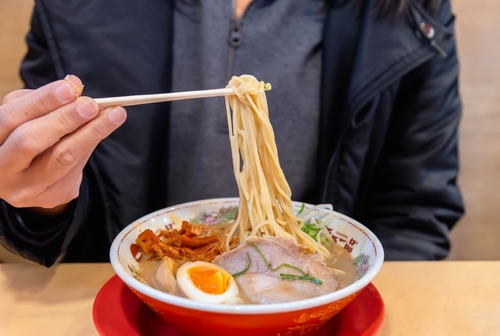Ramen is more than just a bowl of noodles; it’s a symphony of flavors, textures, and aromas. Among its many elements, the ramen egg, or “Ajitsuke Tamago,” holds a special place. This humble yet flavorful component elevates the ramen experience, adding depth, balance, and visual appeal.
But what exactly makes a ramen egg so indispensable, and how can you make one at home? Let’s dive in.
Introduction to Ramen Egg
Brief Overview of Ramen
Ramen is a beloved Japanese dish, known for its rich broths, chewy noodles, and an array of toppings. Originating in China and adapted in Japan, ramen has evolved into a culinary masterpiece with regional variations. Each bowl reflects a careful balance of umami flavors, and every ingredient plays a vital role.
Importance of the Ramen Egg
The ramen egg is not just a topping; it’s a flavor bomb. Its marinated exterior and creamy, soft-boiled yolk provide a luxurious texture that contrasts beautifully with the chewy noodles and hearty broth. Beyond its taste, the ramen egg adds a visual element, with its golden yolk often serving as the star of the bowl.
What is a Ramen Egg?
Definition of Ramen Egg (Ajitsuke Tamago)
Ajitsuke Tamago translates to “seasoned egg” in Japanese. These eggs are typically soft-boiled, with a slightly runny yolk, and marinated in a savory-sweet liquid. The marinade infuses the egg with layers of flavor while giving it a distinctive color.
Appearance and Texture
A perfect ramen egg has a glossy, caramel-colored exterior from the marinade. When sliced, it reveals a vibrant, slightly runny yolk. The whites are tender but firm, while the yolk offers a creamy, almost custard-like consistency that melts in your mouth.
The Role of Ramen Egg in Ramen
Flavor Contribution
Ramen eggs bring a burst of umami to the bowl. The marinade—often a mix of soy sauce, mirin, and sake—adds a salty-sweet richness that complements the broth and noodles. The creamy yolk blends seamlessly with the soup, creating a velvety texture.
Balancing Flavors in the Dish
In a dish as complex as ramen, balance is key. The ramen egg acts as a counterpoint to the rich, salty broth and the chewy noodles. Its mild sweetness and creamy texture help round out the dish, ensuring no single element overwhelms the palate.

Ingredients Needed
To make ramen eggs, you’ll need the following:
- Large eggs
- Soy sauce
- Mirin (sweet rice wine)
- Sake (optional)
- Water
- Sugar (optional, for sweetness)
Preparation Steps
Cooking the Perfect Ramen Egg
- Boil Water: Bring a pot of water to a gentle boil.
- Prepare an Ice Bath: Fill a bowl with ice water to stop the cooking process.
- Soft-Boil the Eggs: Gently lower the eggs into the boiling water and cook for 6-7 minutes, depending on your desired yolk consistency.
- Cool the Eggs: Transfer the eggs to the ice bath and let them cool for at least 10 minutes.
- Peel the Eggs: Carefully peel the eggs under running water to avoid tearing the whites.
Marinating the Eggs
Traditional Marinade Ingredients
The classic marinade for ramen eggs includes:
- 1/2 cup soy sauce
- 1/2 cup mirin
- 1/4 cup sake
- 1/4 cup water (adjust for desired saltiness)
Flavor Variations
For a unique twist, you can experiment with:
- Adding garlic, ginger, or green onions for extra aroma.
- Using dashi (a Japanese soup stock) for a deeper umami flavor.
- Incorporating chili flakes for a spicy kick.
- Combine all marinade ingredients in a bowl.
- Place the peeled eggs in a resealable plastic bag or airtight container.
- Pour the marinade over the eggs, ensuring they are fully submerged.
- Refrigerate for at least 4 hours, preferably overnight, for maximum flavor infusion.

Common Mistakes to Avoid
Cooking Errors
- Overcooking the Eggs: Soft-boiled eggs can quickly turn hard-boiled if left in the water too long. Use a timer to ensure the perfect consistency.
- Improper Cooling: Skipping the ice bath can result in overcooked yolks and make peeling difficult.
Marinating Mistakes
- Too Short Marination: Rushing the process can result in under-flavored eggs. Allow sufficient time for the marinade to work its magic.
- Too Salty Marinade: Balance is key. Dilute the marinade with water if it’s too strong.
Creative Ways to Use Ramen Eggs
Incorporating Ramen Eggs in Other Dishes
Ramen eggs aren’t just for ramen. Here are some creative ways to enjoy them:
- Rice Bowls: Serve sliced ramen eggs over steamed rice with a drizzle of soy sauce.
- Salads: Add halved ramen eggs to your favorite salad for a protein-rich topping.
- Toast: Place a sliced ramen egg on buttered toast for a gourmet breakfast.
Versatility Beyond Ramen
The seasoned flavor and creamy texture of ramen eggs make them a versatile ingredient. Use them in sandwiches, bento boxes, or even as a standalone snack.
Exquisite Cuisine for You
The ramen egg is more than just a garnish; it’s a cornerstone of a well-rounded ramen bowl. Its savory-sweet flavor, creamy yolk, and visual appeal make it an essential component that enhances the dish’s overall harmony.
Making ramen eggs at home is easier than you might think, and the results are well worth the effort. With just a few ingredients and some patience, you can elevate your ramen experience and impress your taste buds. So why not try making your own Ajitsuke Tamago today? Your ramen bowl—and your palate—will thank you.
If you are looking to try exquisite cuisine, do not hesitate to try Yume Ramen & Hibachi. Contact us and experience our cuisine!

